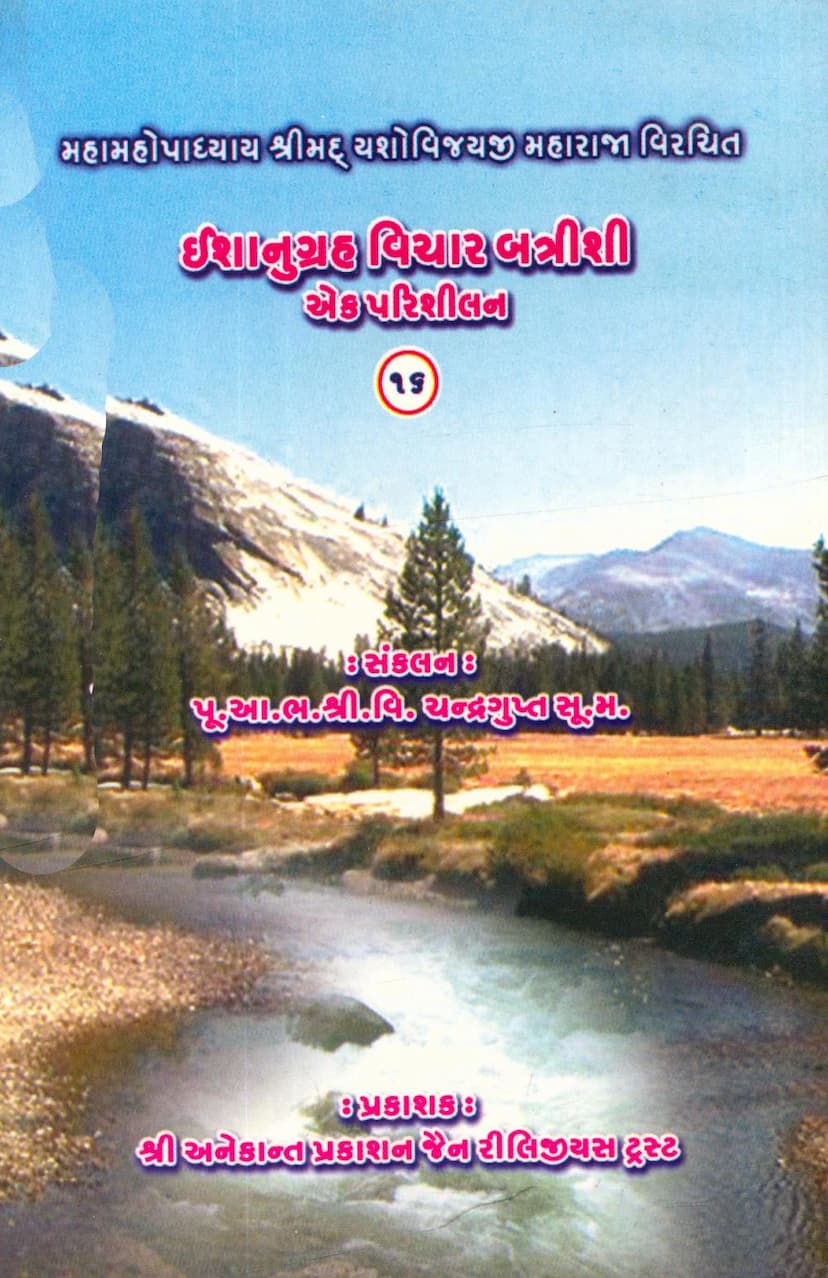Ishanugrah Vichar Battrishi Ek Parishilan
Added to library: September 1, 2025

Summary
This document is an analysis of the "Ishanugraha Vichar Battriishi" (Thirty-two verses on the thought of Ishanugraha) by Acharya Shri Chandraguptasuri. This work is part of a larger commentary on the "Trish-Trishila" by Mahamahopadhyaya Shrimad Yashovijayji Maharaj. The publication is by Shri Anekant Prakashan, with financial support from the family of Shanti Maheshbhai Manubhai and Shanti Nagindas Kachrabhai.
The introduction (Page 4) explains that the original text by Yashovijayji Maharaj analyzes the concept of "Ishanugraha" (Grace of Ishvara/God) from the perspective of Yogadarshana (Yoga Philosophy) and contrasts it with Jain principles.
Key Points from the Analysis:
- Critique of Yogadarshana's Concept of Grace (Page 4-5): The text begins by addressing the Yogadarshana view that liberation (moksha) is attained solely through the grace of Ishvara. It argues against this, stating that Ishvara is the creator and sustainer of the universe, and such a view implies that individual effort is secondary or irrelevant. The analysis systematically refutes this idea, highlighting its illogical nature.
- Jain Perspective on Grace (Page 5): While acknowledging the concept of grace from other philosophies, the analysis suggests that if grace is understood in a Jain context, it might be more acceptable. However, it emphasizes that true understanding comes from studying authoritative Jain texts.
- Patanjali's Obstacles and Liberation (Page 5): The text discusses Patanjali's description of obstacles to spiritual progress and their removal, and the attainment of pure consciousness.
- The Nature of Ishvara (Page 5-6): It references the view of the ancient scholar "Kalateeta" that Ishvara is singular and is one who is completely free from passion (raga) and other afflictions. Different names for Ishvara do not imply different entities. The special qualities described by other philosophers regarding Ishvara are not essential for devotion, and liberation is attained through worship of Ishvara in its formless, passion-free state.
- The True Grace of Ishvara (Page 5-6): The true grace of Ishvara, according to the Jain perspective presented here, is in the form of spiritual teachings that guide individuals towards the path of liberation. By following these teachings and engaging in righteous conduct, one can attain the nature of Ishvara.
- Critique of Other Philosophies' Views on Ishvara (Page 14-46): The subsequent sections (Pages 14-46) delve into a detailed critique of various philosophical views on Ishvara, particularly those that are seen as contradictory to Jainism. This includes:
- The definition of Ishvara as possessing immutable knowledge, detachment, power, and virtue (Page 14-17).
- The idea that Ishvara is the supreme guru of even great sages like Kapila and that the universe operates according to His will (Page 17-19).
- The rejection of the notion that Ishvara's grace alone leads to liberation without the individual's inherent capacity to receive grace (Page 19-21).
- The analysis of Patanjali's concepts like the recitation of "Om" (Pranava) leading to the destruction of obstacles and the attainment of self-consciousness (Page 23-26).
- The description of various obstacles (vyadhi, sthana, pramada, etc.) and how they are overcome (Page 25-33).
- The discussion on how the grace of Ishvara is ultimately linked to following His commands (commands of the liberated souls, the Tirthankaras) and the inherent potential within the soul (Page 33-37).
- The argument that attributing unique qualities like "beginningless purity" or "all-pervasiveness" to Ishvara is ultimately meaningless due to lack of direct perception, conflicting reasoning from different schools (Vedanta, Buddhism), and the ultimate goal of liberation being the same (freedom from passions) regardless of the specific conception of Ishvara (Page 37-45).
- Jain Interpretation of Grace as Guidance (Page 52-53): The text concludes that the true grace of Ishvara lies in the guidance provided through scriptures and the teachings of liberated souls (Gurus). By following these teachings, which are consistent with direct perception and scriptural authority, one attains liberation. The path of liberation itself, consisting of right faith, knowledge, and conduct, is the greatest gift.
- Individual Effort is Key (Page 53-54): The document stresses that while divine guidance is crucial, the actual effort for liberation must come from the individual soul. The Tirthankaras show the path, but the journey is personal.
- The Nature of True Grace (Page 54-57): The ultimate grace is the provision of the path to liberation. The text emphasizes that the path itself, given by the Tirthankaras, is the true form of grace. By following this path with devotion and understanding the qualities of the Tirthankaras, one attains liberation.
In essence, the analysis, based on the work of Yashovijayji Maharaj and commented upon by Chandraguptasuri, aims to clarify and establish the Jain perspective on divine grace, contrasting it with the views of other philosophical schools, particularly Yoga. It posits that true grace is not a direct intervention for liberation but rather the provision of the correct path and guidance, which the individual must then diligently follow.